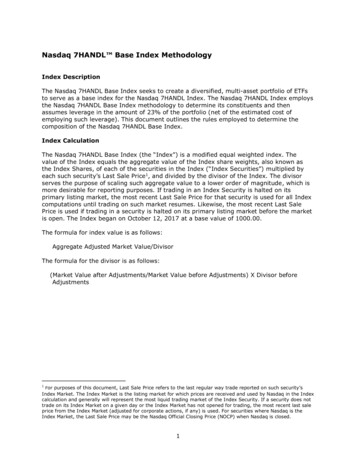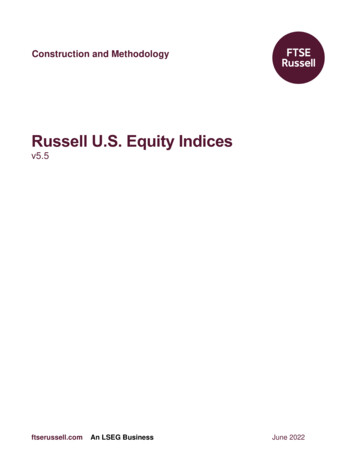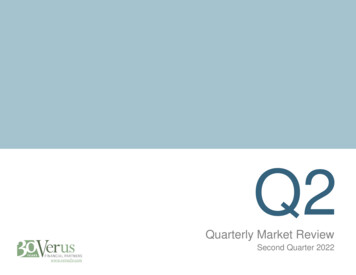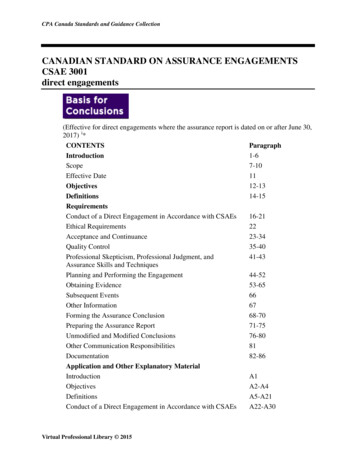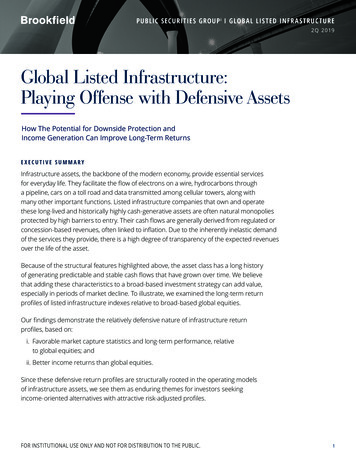
Transcription
The Global Engagement IndexCross-country engagement baselines for team leadersWHITE PAPER SERIEStmbc.com
IntroductionOver the last 20 years, numerous research studies haverevealed the causal link between employee engagement andpositive business outcomes.Teams and business units with higher engagementlevels produce statistically significantly higher levelsof performance, quality, safety and retention. Withorganizations becoming increasingly global, there is aneed to compare business unit levels of engagementacross countries consistently and reliably. This isproblematic, not least because different countriesrespond to ratings scales in different ways. Forexample, South Americans and southern Europeansare much more likely to use the positive extremesof a scale than Chinese, Japanese or Germans.Any employee engagement metric that does notaccommodate these country-specific differences willyield consistently distorted data, leading to inaccurateand misleading cross-country comparisons.Two years ago, The Marcus Buckingham Company(TMBC) set out to design and build a GlobalEngagement Index (GEI) that could take into accountthese inter-country differences and produce reliablycomparable data. In this paper, we present theresearch undertaken to build the GEI and the resultsof its deployment across an initial study group ofthirteen countries.3
PurposeThe purpose of the GEI was threefold:1. To measure reliably the overalllevel of engagement in eachcountry, and to establish a stablebaseline for each country.2. To provide all team leaders witha tool to compare their team’sengagement level against thecountry-specific baseline.3. To reveal, country by country,which conditions in the workplaceare most likely to drive teammembers to become fullyengaged at work.The Engagement Pulse InstrumentThe GEI is derived from the items containedwithin TMBC’s Engagement Pulse (SL8). Theseitems have been developed through decades ofresearch with a focus on reducing measurementand psychometric error (see the TMBC whitepaper Engagement Pulse for full details). In brief,the Engagement Pulse items were intentionallywritten with four specific criteria in mind:(1) A single thought per item — A singlethought measuring one construct peritem helps to reduce the cognitive burdenexperienced by the user.(2) Containing extreme wording — TheEngagement Pulse survey deliberately usesextreme wording to overcome problems withacquiescence (i.e., agreement regardless ofcontent).(3) “Me rating me” — The EngagementPulse was intentionally designed to solicitinformation from team members aboutthemselves, or “me rating me.” We chosethis method to overcome potential issuesthat occur with the ratings of others —namely rater effect and rater insufficiency(i.e., cognitive limitations).(4) Actionable for change — The items aredesigned to be actionable and under thecontrol of the team leader to effect change.4
Below are the 8 items of the Engagement Pulse (SL8), measured on a Likert scale (1–5):Purpose1. I am really enthusiastic about the mission of the company.2. At work, I clearly understand what is expected of me.Excellence3. In my team, I am surrounded by people who share my values.4. I have the chance to use my strengths every day at work.Support5. My teammates have my back.6. I know I will be recognized for excellent work.Future7. I have great confidence in my company’s future.8. In my work I am always challenged to grow.The odd-numbered items measure aspects of theworkplace that are communal — the “We” of theworkplace. The even-numbered items measureaspects of the workplace that are individual —the “Me” of the workplace. In combination theycapture the twin challenges of leading a teameffectively: first, how to conjure within the teamfeelings of shared purpose, values, meaningand future; and second, how to ensure thateach person feels understood, challenged anddeveloped as a unique individual.5
Data OutputThe GEI metric yields two related but distinctscores:1. Level of Engagement:This score, expressed as a numberbetween 1–100, reveals a team’s(or company’s/country’s) overalllevel of engagement. It is the mostreliable and calibrated summaryof the entire data set of the team(or company/country).2. Extreme of Engagement:This score, expressed as a “% FullyEngaged,” reveals the percentageof a team (company/country) whoare psychologically committedto their work. These people arededicated to the purpose of thecompany, certain in their definitionof excellence, confident in thesupport of their teammates, andexcited by the company’s future.6The two scores produced by the GEI co-vary, andyet they also diverge in important ways. Someteams have a relatively high level of engagementbut low “% Fully Engaged.” Others have theinverse pattern: a high “% Fully Engaged,” andrelative lower overall level. Although the ideal isto have a team that scores positively on both,of the two, the “% Fully Engaged” score is themore important.
Why Is “% Fully Engaged” theMore Meaningful Score?The purpose of an employee engagement metric isnot to measure engagement. Instead, its purposeis to help a team create more productive behaviors.A significant body of previous research reveals thatwhat best predicts these productive behaviors —such as lower turnover, fewer accidents, higherproductivity, and customer satisfaction — is thepercentage of team members who can report“strongly agree” to the items in the metric. TopBox responses are the best predictor. Manyorganizations, apparently unaware of this, chooseto combine the top two boxes into a “percentagefavorable” score. This is an unhelpful aggregationof the data because, when it comes to predictingsubsequent employee behavior, 4s operate morelike 3s than they do like 5s.By measuring precisely the number of teammembers who report extreme levels ofengagement, the “% Fully Engaged” scorehelps the team leader (and the company) predicthow productive the team is going to be in thenear-term future.Those team members who are not “FullyEngaged” are not necessarily disengaged.Some survey instruments suggest that thereis a gradation of engagement descending fromfull engagement to disengagement to activedisengagement. This is neither accurate norhelpful. All engagement metrics are designedto measure engagement. However, since it isimpossible to measure the exact opposite ofsomething by asking about that something,these engagement metrics have very little to sayon disengagement.Thus, while the GEI has a “% Fully Engaged”threshold and can measure how many teammembers are above that threshold, the most itcan say about those who fall below the thresholdis that their engagement, and therefore theirsubsequent productive behaviors, cannot bepredicted. Since the only accurate predictionto be made about them is that their level ofengagement is non-predictive, the GEI simplydescribes these team members as “Comingto Work.” The absence of engagement is notnecessarily active disengagement.7
The Global StudyThe items were translated into eight languages:English, German, French, Spanish, Latin AmericanSpanish, Portuguese, Chinese, and Italian.The translations were then back-translatedindependently to ensure that content, accuracyand the idiomatic meaning of the items werecaptured correctly.In April and May of 2015, the items were fieldedto a random stratified sample of 1,000 workingadults from 13 countries: United States, Britain,Germany, France, Canada, Brazil, Argentina,Australia, Mexico, China, Italy, Spain, and India.Cross-Country CalibrationPast research suggests that individuals respondto survey items differently based on language andculture. This source effect introduces error intothe survey measurement. To control for this error,the items were adjusted across countries usinga sub-set of items, the “calibration items.” Itemmeans were calculated within each country, andthen compared to the grand mean. This differencewas treated as a cultural/language effect, and theengagement data were adjusted. Further analysisthen proceeded with these adjusted data.8Power Weighting CalibrationThrough past research, we identified which ofthe eight items are the most powerful predictorsof productive employee behaviors, and have themost explanatory power of overall engagement.These items were given additional weightings.ResultsWe completed a multi-group confirmatory factoranalysis (MG-CFA) of the eight EngagementPulse items to determine whether this newglobal sample had the same factor structure aswe had previously established (see the TMBCwhite paper Engagement Pulse for full details).As before, only one stable factor emerged. Theseeight items measure one coherent factor which,given the purpose for which the survey was built,we will label “engagement.”These weightingswere then incorporated into an algorithm.To generate the GEI scores, we took the calibrateddata by country and then applied this algorithm.
GEI Level: Comparison by CountryThe GEI level for each country was standardizedto allow for comparison across all countries. Somevariance within each country does exist but, bydesign, little variation occurs across countries.MeanMedianMaxGlobal Engagement Index LevelMinGlobal Sample9
GEI Extreme:“% Fully Engaged” by Country% Fully EngagedThe percentage of “Fully Engaged” employeesvaries by country more dramatically. Inquantitative terms, this score represents thoseindividuals within a country whose responsesto the items, after the calibration and algorithmare applied, are above the “Fully Engaged”threshold. Qualitatively speaking, these individualsare dedicated to the purpose of their company,certain in their definition of excellence, confidentin the support of their teammates, and excited bytheir company’s future.Global Sample10
In Each Country, What Causes aTeam to Become Fully Engaged?Even with one factor, we wanted to understandwhat made a team member “Fully Engaged” ascompared to “Coming to Work.” We separatedthe overall sample and selected only those whowere “Fully Engaged” to understand what drivestheir engagement within each country. Wethen performed a number of different statisticalanalyses to understand the interrelationshipbetween the items, and between the items andthe “Fully Engaged” threshold.Findings: The Most Powerful ItemDespite obvious cultural differences between thecountries in the study, we discovered that thesame one item demonstrated the greatest powerin explaining engagement in every country in thestudy. Item #4:I have the chance to use mystrengths every day at work.This finding is consistent with previous research— conducted by TMBC and others — showingthat teams whose members feel that they havefrequent opportunities to do their best workoutperform those teams whose members do not.Even after applying the country-specific calibrationand the power algorithm, this item still possessedmore explanatory power than any other. Thissuggests that there is far greater consistencyaround the world to what team members wantfrom their work than one might have expected.Although corporate methods, behaviors andvalues vary by country — and by industry — themost powerful human need at work remains thesame: help me discover my strengths, and helpme use them a lot.11
Findings: Differences by CountryThough item #4 is the foundation of fullengagement in every country in our study, furtheranalyses revealed that different configurationsof items explained full engagement in differentcountries. This suggests that, though thefoundation of a Fully Engaged team is the samethe world over — “Play to my strengths” — thenext “bricks” laid upon that foundation varyby country. Companies and team leaders needto be aware of these variations if they are tosuccessfully build more teams like their mostengaged teams. In the United States, the next most powerfulpredictor of Full Engagement is item #1: Iam really enthusiastic about the missionof the company. This suggests that, in theUS, the best way to build an effective teamis to tie each person’s unique strengths to auniversal purpose in which everyone can findshared meaning. Strengths in the service ofmission lead to a fully engaged team. The two countries whose workplace statisticsmost closely resemble the United States’ inthis respect are China and Germany. Thoughmany cultural differences exist betweenthese three countries, they all appear to sharean appetite for a communal mission. The bestway to build a fully engaged team in Chinaand Germany — and the US — is to rallypeople toward a shared and noble goal.12 This is not so in the UK and India. In thesetwo countries, item #3 is the next strongestpredictor of a fully engaged team: In myteam, I am surrounded by people whoshare my values. This suggests that in theUK and India, a sense of grand purpose is lesspowerful and less relevant than the sensethat my teammates all value what I value. Fullengagement, then, is a result of considered,rational and parochial calculations, rather thanpassionate enthusiasm for a shared cause. France and Canada display a different patternfrom any of the countries described above. Itis a pattern they share with each other, and,interestingly, with Brazil and Argentina. Inthese four countries, the next block laid uponthe foundation of “play to my strengths” isitem #5: My teammates have my back.In contrast to items 1 and 3, this item isneither emotional nor rational, but is insteadinstinctive. It measures a gut-level feeling that“I am covered.” This suggests that in thesecountries a fully engaged team has the qualityof a tight-knit group of teammates who muststick together, protecting one another fromexternal threat. A Fully Engaged team is adefensive unit. Australian teams display another patternaltogether. In Australia, the most powerfulnext building block is item #7: I have greatconfidence in my company’s future.“Confidence” and “future” are obviously the
trigger words in this item. To create a fullyengaged team in Australia, the team leadermust delineate clearly the future businesscontext and must reassure the team that theypossess some sort of material comparativeadvantage in that future context. Teammembers appear to be demanding of theirleaders: “Tell me why we will win.” Spain’s pattern is different again, and isperhaps best explained by their currenteconomic environment — and thus raisesthe question of whether these patternsare enduringly stable or whether theywill fluctuate based on macroeconomicconditions. (We will study this over time.) InSpain, the biggest driver of Full Engagementis item #8: In my work I am alwayschallenged to grow. Though Spaniards maywant many things from their workplaces, theneed that integrates and explains all othersis that, on this team, I see a way for me togrow my skills, and even my career. Whenone combines this item with the “play to mystrengths” item — which is the foundationof Full Engagement in Spain, as in everycountry in our study — a picture emergesof a workforce preoccupied with their ownpresent and future worth. All team membersin all countries share these preoccupations,of course, but in present-day Spain theyare amplified. Given the current economicsituation in Spain, this is hardly surprising.13
ConclusionThe GEI fills an alarming gap in ourunderstanding of global employee engagement.Through the combination of the country calibrationand the power algorithm, it provides team leaderswith a reliable metric to measure their team’soverall level of engagement, and their extremesof engagement, using the “% Fully Engaged”score. It also reveals the levers that best explainwhat drives full engagement within a particularcountry and culture.Since TMBC’s mission is to serve teamleaders the world over, we plan to give theGEI away to all team leaders through theSurveyMonkey platform.In addition to the data gathered through theplatform, we will repeat and extend this globalstudy yearly. Our hope is that this ongoingresearch will yield an increasingly preciseunderstanding of global engagement, and therebycontribute to all team leaders’ ability to build morefully engaged teams.14
IN0093 GEI white paper r02v01 2017 by TMBC.All rights reserved. Reproduction in any form without the express written consent ofThe Marcus Buckingham Company is prohibited.
Though item #4 is the foundation of full engagement in every country in our study, further analyses revealed that different configurations of items explained full engagement in different countries. This suggests that, though the foundation of a Fully Engaged team


